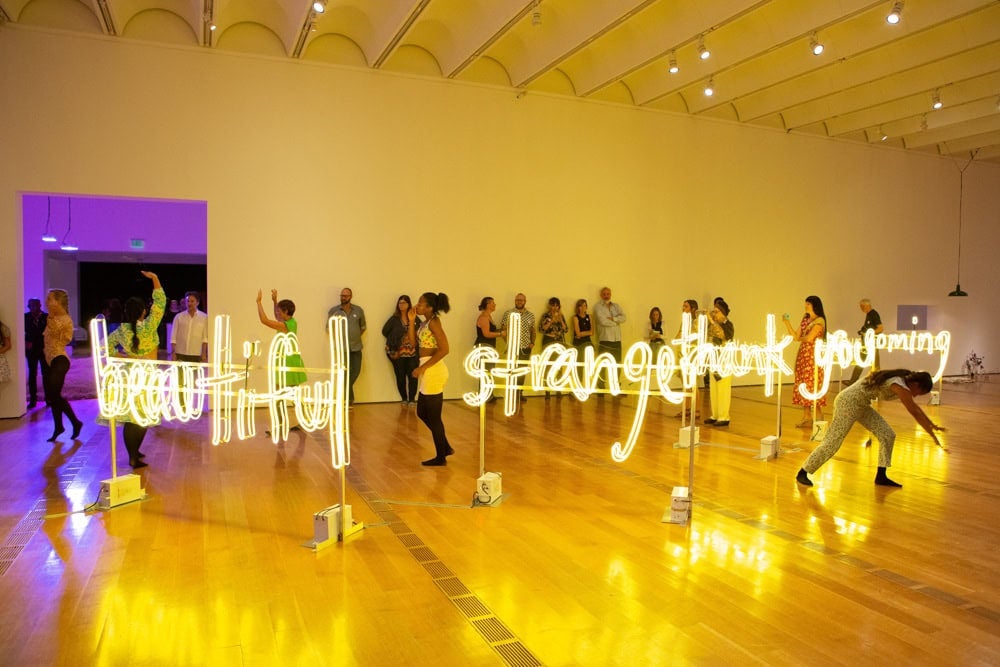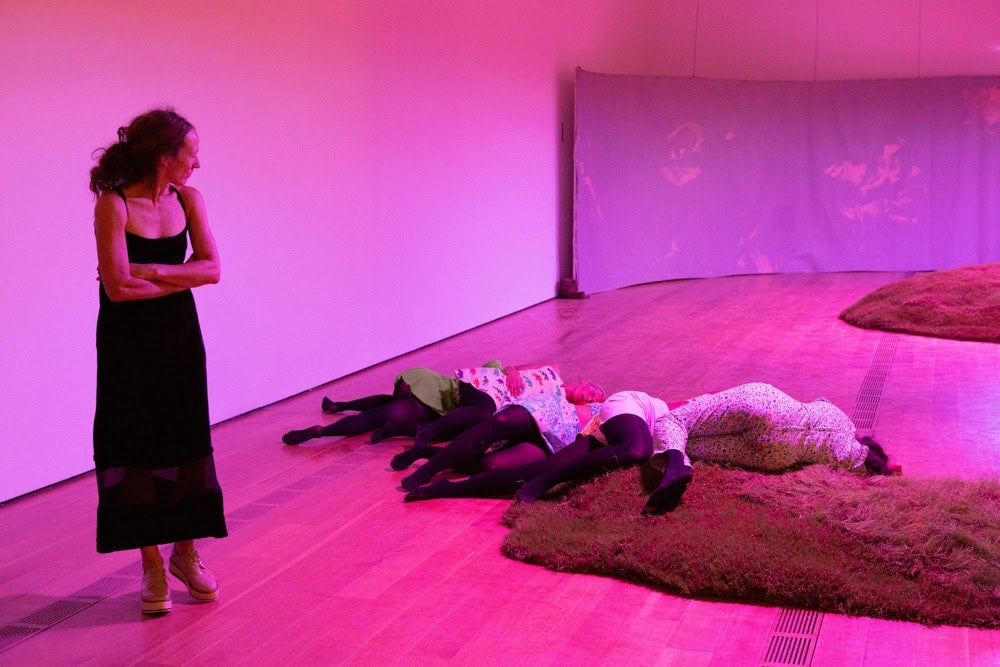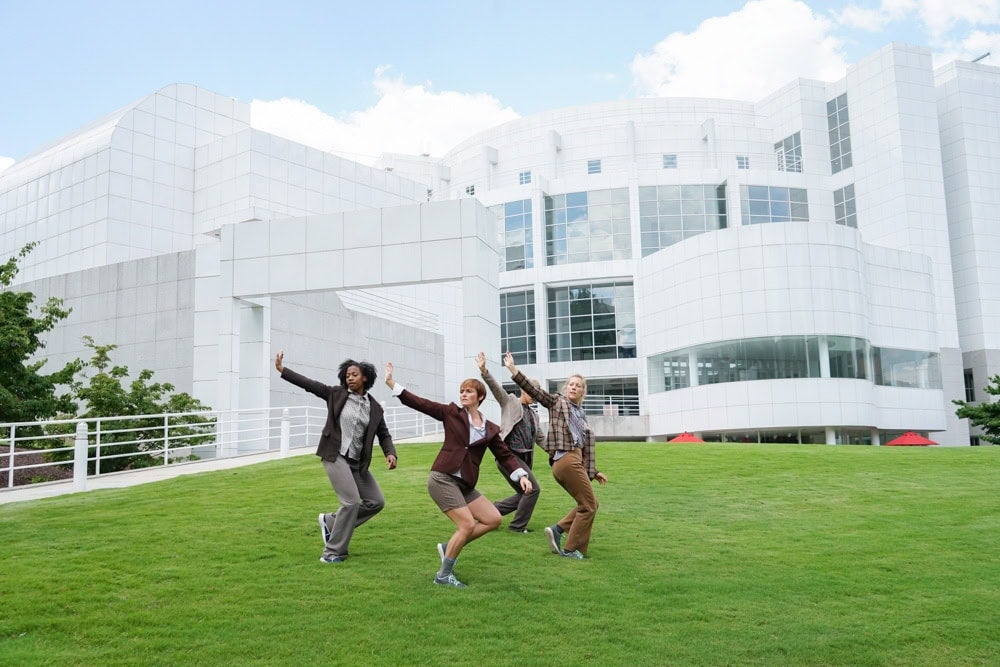
A bird flies into the room.
No! A bird flies into this room.
No! A woman flies into this room.
No! A tribe of women flies into this room.
These words are projected on the walls of the Cousin’s Gallery at the High Museum of Art in Atlanta. What does it mean for a woman to fly free, as a bird flies? What does it mean for women and children to fly free within a museum?
In sometimes stifling institutional spaces, an action as simple as clapping your hands can constitute a political statement. When you disrupt the air and create the reverberating sound, the space changes. Supple Means of Connection—a series of performances, installations, and public activations by choreographer Lauri Stallings and the movement collective glo—similarly holds the potential to disrupt and transform the institutional parameters and operations of the High Museum of Art.

Supple Means of Connection is about how humans touch, the countless ways in which we caress and grate against each other. As a choreographer, Stallings is deeply invested in spatial transformation and placemaking. Prior to its five-week residency at the High, glo was based at the Goat Farm Arts Center’s Goodson Yard since 2011. Stallings brought machinery, earth, and audio recordings of birdsong from Goodson Yard, incorporating them into the installations in the museum galleries. These include text-based neon sculptures, mounds of sod where visitors can lounge and bathe in artificial light, and booths and other pop-up structures for visitors to interact with and explore. Through these installations and the accompanying performances, glo has constructed new conditions of museum-going that break down the barriers between performers and viewers. The project functions as an invitation to interact with the artists, the institutional space they occupy, and other viewers in ways which were previously not possible at the High.
Stallings choreographed a suite of movements and live art installations that exhibit the technique, endurance, and power of the twenty-four moving artists who comprise glo. The intergenerational, interracial group performs for the duration of the museum’s open hours for the length of their residency. Beyond the gallery housing the neon sculptures and other installations, the performers spread throughout the museum through activations such as Ceremonial Living Sculpture, which takes place in the atrium, and Mapping: Public Choreographies. The artists move in conversation with artworks throughout the museum and the architecture of the building itself, creating new associations with their bodies. This movement continues through the doors of the museum, beyond the paywall and security guards, out onto Peachtree Street. Stallings has created a performance that brings what’s inside outside and vice versa, an interactive, democratic experience that playfully rejects the institution’s largest accessibility barrier: the price of the ticket.

As critic Jordan Amirkhani wrote for this magazine in her review of Deborah Roberts’s solo exhibition last year at the Spelman College Museum of Fine Art, “The art museum… is a place where the ‘unconsciousness’ of Western (art) history and its roots in capitalism, racism, imperial colonialism, and heteropatriarchy can perpetuate and manifest unchecked, based on institutional presumptions of a white audience and white critical network amplifying and naturalizing a whitewashed cultural history.”
Supple Means of Connection undoes these structural conceptions of the museum simply by inviting women and children to freely and deliberately take up space. Seeing groups of women move in concert across the gallery or along the grounds of the museum is striking; watching children idly move together in the gallery free of stanchions and corralling guards is freeing. These are powerful gestures that have intangible effects on how we see, interact, and place value within the very tangible museum. Stallings presents the female body not as a sitter, object, or subject, but as the artist. These women and children are not only inhabiting institutional space—they are transforming it, reconfiguring it to make room for their stories, experiences, and ideas expressed through movement. The performances that happen day after day, week after week, lay the foundation for a new type of intersectional institution where women, children, and people of color share access and proximity to the engines of cultural power. In Atlanta, at the High, this is a subtle act of decolonization.
As an institution with major impact on art communities in Atlanta, what a residency like this means for the High Museum of Art is that it cannot turn back. The space is changing and continues to change every time the performances begin. Supple Means of Connection reveals where museums fall short and opens a conversation on how institutions can become less guarded and restrained. It is rare that the orchestra steps outside of the concert hall, the play leaves the theater, or that you catch a graffiti artist between cans of spray paint, and even rarer that they invite you to create with them. Intentionally or unintentionally, Stalling’s work is taking bricks from the boundaries that divide us. Through artmaking, we can tear down the walls of the museum and let everyone in.
The installations and activations comprising glo’s Supple Means of Connection are on view at the High Museum of Art in Atlanta through September 8.




